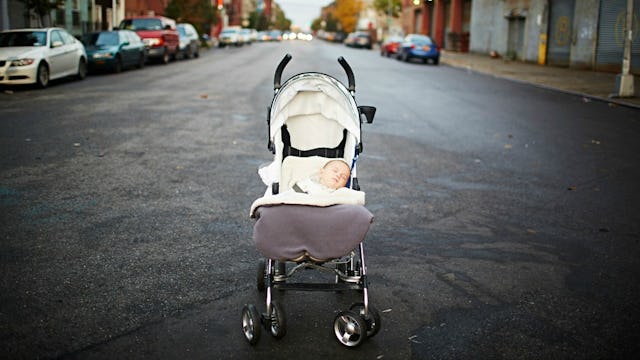Most Parents Don't Understand The Risk Of Positional Asphyxia In Infants

Trigger warning: child loss, SIDS
With the latest Fisher Price Rock N’ Play recall, the controversy continues to thicken among parents regarding whether they will continue to use these baby rockers, or do as the recall suggests and return them or throw them out. But it’s not just Rock N’ Plays that pose a dangerous threat for possible death by positional asphyxiation; it’s any product that lets infants sleep in an unsafe position.
Everything? Yes, nearly everything — couches, infant carriers, baby swings, baby bouncers, infant sleep positioners, and car seats. Bottom line: if it’s not a flat surface and they aren’t asleep on their back, there is an additional risk for death by positional asphyxiation.
Positional asphyxia can happen to anyone, but it’s most common in infants when a baby cannot get enough oxygen to breathe due to the positioning of their body. Some believe this type of asphyxiation is a result of an infant being trapped between a surface, with their nose and/or mouth covered and restricting air. And while this absolutely is the cause for some positional asphyxia infant deaths, it’s certainly not the cause for all of them.
Infants under four months old do not have proper head and neck control and are unable to move their head should airways become compromised. And the frightening fact is that their little airways can become inhibited just by the tilt of their head (for example: when their chin is against their chest).
And what about carbon dioxide re-breathing? Carbon dioxide re-breathing happens when an infant continues to re-breathe the air that was previously exhaled. This happens when a baby turns their head into something such as fabric and it prohibits the proper amount of oxygen from being inhaled. And horrendously enough, a baby’s mouth or nose do not have to be covered in order for this tragedy to occur.
It’s because of this that the American Academy of Pediatrics suggests laying infants under one on a flat surface, alone and on their back while sleeping.
But what about the countless parents taking the internet by storm with this most recent recall? Maybe you’ve seen them. They are the ones holding a Rock N’ Play, ranting and raving (almost promoting) about its life-saving capabilities — despite the recall. They boast about their “just fine” babies, and seem to somewhat claim negligence on grieving parents. After all, if these parents would have just “watched their baby,” everything would have been “just fine.”…. as if they possess some type of crystal ball.
Folks, do not be fooled or spread those false claims. For these posts are, sadly, a general lack of awareness about positional asphyxia.
You might be wondering, well, what does this author know about positional asphyxia anyway?
I know that my daughter died from SIDS.
I know that SIDS is not a diagnosis; it is a broad cause of death that is given when no other cause of death can be found after an autopsy and a through investigation of the scene.
I know that death by positional asphyxiation is sometimes thrown under the bigger question mark known as SIDS because of its uncertainty in certain cases.
I know that my daughter was unsafely sleeping on a sectional sofa with me the morning that she died.
I know that I’ve researched myself sick on the topic.
And I know that I will never have certainty about how she died, but positional asphyxia is among one of the potential causes.
I know all of these things, and I want you to know that this isn’t something happening to just the negligent, unable-to-follow-warning-instructions parents. Positional asphyxia snatches innocent lives without warning signs everyday, and it happens to even the most careful of parents.
There is no gasping for breath or screaming and wailing — it is the silent killer. And if an infant under one sleeps in anything not designed for safe-sleep, there is an added risk for death by positional asphyxiation even with a responsible caregiver in the same room.
Risks are everywhere we look, and we cannot protect our children from every last one of them. But the ones that we can, we definitely should. Of course, parents will fall asleep with their babies whether they intend to or not (hello, sleep deprivation) and many parents choose to co-sleep or bed-share for a variety of reasons — which makes education about how to do so safely all the more important.
Parents should:
– Sleep in the same room with baby until they are a year old.
– Use sleepers instead of blankets.
– Put baby to sleep on a flat surface.
– Throw out or return recalled baby items.
– Keep baby away from second and third-hand smoke.
– Put baby to sleep on their back.
– Create a safe space without pillows or blankets if deciding to co-sleep or bed-share.
– Refrain from using drugs and alcohol.
No parent is perfect, and I’m going to go out on a limb to say that every parent has accidentally (or maybe intentionally) used infant sleep practices that are deemed unsafe in some way. Therefore, it’s ignorant for someone to assume that positional asphyxia could never happen to them or their child. It. Does. Not. Discriminate.
And it’s even more ignorant to assume it could never happen to you if you’re continuing to use a recalled baby product linked to 30 infant deaths by positional asphyxiation. There is no safe way to use a recalled baby product. And if you choose to disregard these types of recalls, you are actively putting your child at risk.
You are never too normal, happy, loving, or capable for tragedy to hit you. Because that’s what positional asphyxia is; it’s a tragedy. Let it be that and not an already learned life-lesson for mourning parents.
This article was originally published on